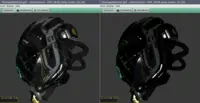texture_color = texture2D(Material.emissiveTexture)
screen_color = UnlitMaterial.emissiveColor * texture_color
final_screen_color = screen_colorColor Space (Gamma Correction)
1. What is Linear Color Space and Gamma Correction
Linear Color Space (Gamma Correction) in 3D graphics means that the lighting is calculated in more correct way.
The images you prepare on your computer, and photos you take with your camera, have colors automatically adjusted to look good on a typical monitor. Using these colors directly for the lighting calculation (e.g. as diffuse or base colors) is not entirely correct.
Linear Color Space (Gamma Correction) means that the graphic engine (like Castle Game Engine) does this:
-
Adjusts the values from the color images (like textures you provide to X3D
TPhysicalMaterialNode.BaseTexture,TMaterialNode.DiffuseTexture,TAbstractOneSidedMaterialNode.EmissiveTexture) into more correct values, before using them in any calculations. -
Calculates the lighting using the correct color values.
-
At the end, applies a correction back to the final pixel color, to make it look good on your monitor.
More description of gamma correction and linear color space:
2. Using Gamma Correction in CGE
In Castle Game Engine you control this using a simple global variable ColorSpace.
-
By default it is
csLinearWhenPhysicalMaterialwhich means that we calculate in linear color space (do gamma correction) for materials using PBR (Physically Based Rendering) equations. This includes standard materials defined in glTF models, and materials defined in X3D 4.0 using explicitPhysicalMaterialnode. So we assume that you prepare PBR materials and their textures for a linear workflow (color space calculation). -
You can change it to
csSRGBto never do gamma correction (calculate in sRGB space). -
You can change it to
csLinearto always do gamma correction (calculate in linear space).
Another way of explaining it is by looking at the material node (used by each X3D Shape):
-
PhysicalMaterial: Linear color space (gamma correction) is used ifColorSpaceequalscsLinearWhenPhysicalMaterialorcsLinear.This material type is the standard glTF material type. You can also use it explicitly by
PhysicalMaterialX3Dv4 node. -
MaterialandUnlitMaterial: Linear color space (gamma correction) is used ifColorSpaceequalscsLinear.Materialis the standard X3D 3.x material type, practically used by all existing X3D exporters right now.UnlitMaterialis the new X3Dv4 node. It can also be used by glTF models that use KHR_materials_unlit material type (e.g. Blender can export such materials in glTF).
What you should do?
-
In most cases, the default does what you expect.
If you use glTF models with PBR, then gammma correction is used.
Otherwise gamma correction is not used. So unlit materials (e.g. with cartoon rendering) have no gamma correction. Older models with Phong lighting have no gamma correction.
-
If you want linear color space (gamma correction) always then turn
ColorSpace := csLinear. Make sure you prepare your assets (textures) accordingly. This is also 100% compatible with glTF (that dictates one should use gamma correction always, for both PBR and unlit materials). -
If you want maximum speed, set
ColorSpace := csSRGB.If you want maximum speed, you may also consider using Phong lighting (maybe even with Gouraud shading) instead of PBR. IOW, using
Materialinstead ofPhysicalMaterialX3D nodes. And of course useUnlitMaterialfor unrealistic rendering. But these decisions are independent of the gamma correction, that in principle makes sense with any lighting model (even unlit).
|
Note
|
Color space (and gamma correction) only affects things rendered using TCastleScene in TCastleViewport. It is not applied to other things. In particular user-interface elements (like TCastleButton or TCastleImageControl) or low-level 2D APIs (like TDrawableImage) ignore the ColorSpace setting.
|
3. Why does this matter also for unlit materials (that don’t calculate lighting)?
If you use linear color space calculation, then the TUnlitMaterialNode.EmissiveColor is assumed to be provided also in linear color space.
But the texture colors, read from the TUnlitMaterialNode.EmissiveTexture, are assumed to be provided in sRGB color space.
|
Note
|
This is consistent with treatment of all other colors and color textures. Like TPhysicalMaterialNode.BaseColor and TPhysicalMaterialNode.BaseTexture. Actually they all have an emissive part, defined at TAbstractOneSidedMaterialNode.EmissiveColor and TAbstractOneSidedMaterialNode.EmissiveTexture.
|
When the linear color space calculation is not used for unlit materials, then the calculation is like this:
But when the linear color space calculation is used for unlit materials, the calculation is like this:
texture_color = pow(texture2D(Material.emissiveTexture), 2.2) // convert texture sRGB -> linear
screen_color = UnlitMaterial.emissiveColor * texture_color
final_screen_color = pow(screen_color, 1 / 2.2) // convert linear -> sRGB for screenAs you can see, the UnlitMaterial.emissiveColor is not processed by pow at input — it is assumed to be already in linear color space. So when the UnlitMaterial.emissiveColor is not white (1, 1, 1), then the resulting screen color RGB is not exactly equal to UnlitMaterial.emissiveColor (or UnlitMaterial.emissiveColor multiplied by UnlitMaterial.emissiveTexture, if texture was provided).
To improve this documentation just edit this page and create a pull request to cge-www repository.



